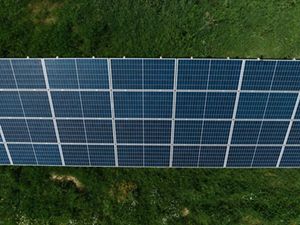The Nature Conservancy Jointly Launches 12 New Principles and “First-of-a-kind" Guidebook to Accelerate Renewable Energy while Protecting Biodiversity
Power Plant 2.0 from Eurelectric incorporates input from civil society and industry to provide guidance for policymakers and developers
Media Contacts
-
Barbara Kuznik
The Nature Conservancy Europe
Email: barbara.kuznik@tnc.org
Launched today, PowerPlant 2.0 – a first-of-a-kind guidebook developed by WSP and issued by Eurelectric – will serve as a vital tool for the industry to scale up biodiversity integration and achieve the best outcomes for both people and nature. The guidebook features twelve new principles, policy recommendations and real-life case studies, providing a comprehensive framework for developers to incorporate biodiversity considerations throughout the lifecycle of renewable and grid projects.
As the world grapples with alarming environmental decline, characterised by more frequent extreme weather events and rapidly growing biodiversity loss, Europe's power system is undergoing an unprecedented transformation. To meet the EU's decarbonisation targets, which include doubling renewable capacity by 2030, there is an urgent need to integrate biodiversity into renewable energy projects. The EU Biodiversity Strategy acknowledges that the current energy systems, responsible for over 75% of the EU's greenhouse gas emissions, must evolve.
Power Plant 2.0 is the latest initiative borne out of a policy cooperation between The Nature Conservancy and Eurelectric, launched at the COP27 in Egypt, which aims to build confidence among policymakers and other stakeholders that Europe’s 2030 renewable energy targets can be credibly achieved by accelerating deployment of renewable energies in ways that deliver on both the EU’s climate and biodiversity objectives.
Noor Yafai, TNC’s Europe Director for Global Policy and Institutional Partnerships, one of the speakers at the launch event, emphasises the importance of this initiative:
“This guidebook is a first-of-its-kind effort bringing together industry and civil society to develop a new set of key principles and concrete solutions to accelerate renewable energy in ways that also protect and restore nature. Alongside the industry’s longstanding support for the EU Nature Restoration Law, this new guidebook is an inspiring example of European industry and civil society joining forces to lead the way - especially as we think about how the world will meet its new ‘triple renewables' goal alongside other nature and climate goals which hundreds of countries have also committed to.
“Policymakers must ensure such projects are incentivised through policies that adequately reward front-runners who are integrating nature protection and restoration in their project designs. This can be done through incorporating biodiversity non-price criteria in national renewable energy auctions, and developing an EU-wide framework that would help define the concept of ‘biodiversity net gain’ in order to reward projects that provide a net positive benefit for nature. It will also be vital to pass the EU Nature Restoration Law, as this industry has been consistently calling for, and this new guidebook also highlights.”
“In the next steps, we would like to see more focus evolving on best practices engaging people and communities in early planning stages. This new guidebook could then ultimately help to establish a set of internationally recognised renewable energy development principles and equip many more regions and countries to accelerate renewables in harmony with nature. We really don’t have any time to lose to reverse biodiversity loss and halt climate change, so we need all hands on deck - including policymakers, investors and corporate actors - to scale up biodiversity-integrated renewable projects. Ahead of COP16, the next big milestone towards delivering the Kunming-Montreal Global Biodiversity Framework, this new collaboration between industry and civil society could help showcase how renewables can help not hinder solutions to the biodiversity crisis.”
Kristian Ruby, Secretary General, Eurelectric:
“With this Guidebook, developers of clean energy projects get a tangible tool to follow best practices in nature protection. Transparency and societal involvement are central to the philosophy of the Power Plant project. Therefore, Eurelectric is delighted by the active engagement of The Nature Conservancy in the project.”
The guidebook follows on from the first Power Plant project two years ago, which showcased good practice examples of renewables that integrate biodiversity into their design.
In PowerPlant 2.0, as the next level of collaboration with Eurelectric, TNC participated as a member of both the expert group and advisory board, providing technical and policy expertise, emphasising the importance of smart siting to minimise impacts on biodiversity and create potential for nature restoration. Additionally, TNC highlighted the importance of strict adherence to the mitigation hierarchy to ensure environmental integrity.
Learn more about TNC's work to accelerate renewable energy in harmony with nature and people here.
The Nature Conservancy is a global conservation organization dedicated to conserving the lands and waters on which all life depends. Guided by science, we create innovative, on-the-ground solutions to our world’s toughest challenges so that nature and people can thrive together. We are tackling climate change, conserving lands, waters and oceans at an unprecedented scale, providing food and water sustainably and helping make cities more sustainable. The Nature Conservancy is working to make a lasting difference around the world in 81 countries and territories (40 by direct conservation impact and 41 through partners) through a collaborative approach that engages local communities, governments, the private sector, and other partners. To learn more, visit nature.org or follow @nature_press on X.



